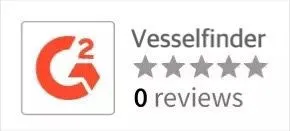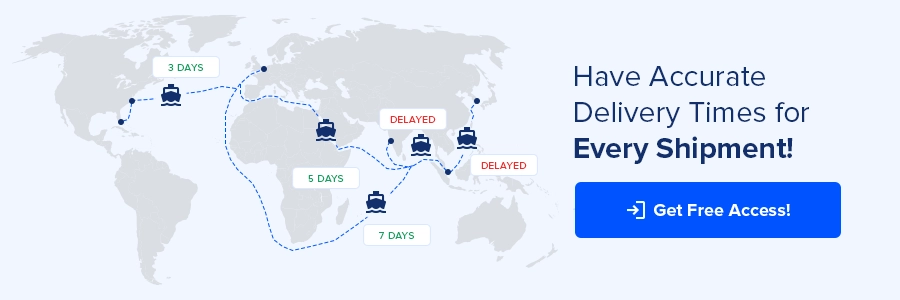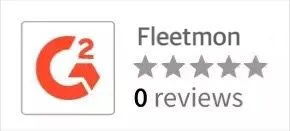Top 15 Vessel Tracking Software for the Maritime Industry in 2025
Feeling swamped with endless spreadsheets and struggling to keep up with your fleet? It’s time to now ditch the old methods and embrace modern vessel tracking software. Imagine having all the vital information you need—real-time locations, route optimizations, and fleet performance—instantly accessible. No more frantic calls or outdated data. Vessel tracking tools can transform your fleet management into a well-oiled machine. Ready to navigate smoothly? Dive into our blog and explore the top 15 solutions to make managing your fleet easier than ever!
How should you evaluate any Vessel Tracking Software?
When selecting vessel tracking software, several factors should be considered to ensure you choose the most suitable solution. Here are some key factors to consider:
Accuracy and Reliability: The software should provide accurate and reliable vessel tracking information, including real-time positions, speed, heading, and other relevant data. Look for a software provider with reliable data sources and a track record of delivering accurate information.
Carrier-level integration for better visibility: The platform should integrate multiple shipping lines and third-party cargo lines to improve ETAs and delay statuses. Any platform like GoComet, which uses a mix of AIS and carrier data, can give better insights on ETA.
AI-powered AIS system: Depending solely on real-time data can be problematic when the system needs to be more intelligent to forecast delays that can hamper your supply chain from production planning to last-mile customer delivery. Along with displaying AIS signals in real-time, the platform should also store, crunch and produce business insights in the form of predictive ETAs, identify critical routes and send advanced alerts that can get you prepared for any delays before your shipment sails
However, it is important to remember that Tracking software’s are an investment for long-term growth of your company. Hence, we have compiled all essential questions your Vessel Tracking Software MUST meet to ensure it being worth your time and money,

16 Features to ensure your
Vessel Tracking Software
is a Valuable Investment
The 15 Best Vessel Tracking Software options to consider
1. GoComet
GoComet is easily one of the best and most comprehensive vessel tracking software, providing real-time location tracking and monitoring of ships and other vessels worldwide. It is designed to help businesses in the shipping and logistics industry manage their operations efficiently and effectively. GoComet leverages advanced satellite and communication technologies to provide users with up-to-date information on vessel locations, routes, and conditions.
With GoComet, users can easily track their shipments and vessels using the intuitive and user-friendly platform. The software allows users to monitor multiple vessels simultaneously and provides alerts for vessel location or condition changes for instance delays due to Port Congestion. This helps businesses stay informed and make informed decisions about their shipping operations. Additionally, Gocomet offers a range of customization options, allowing companies to tailor the software to their specific needs.

2. MarineTraffic
MarineTraffic is an online platform that provides real-time vessel tracking, marine weather information, and port data. The software offers an intuitive interface and comprehensive fleet management and monitoring tools. The platform utilizes AIS technology to track ships’ movements in real-time.
3. VesselFinder
With real-time vessel positions, port calls, and navigational aids, VesselFinder is an international AIS vessel tracking service. Fleet management and vessel tracking are two primary uses of this platform by shipping firms and marine security organizations. Users can use various tools for tracking and managing fleets on VesselFinder, which provides real-time vessel positions. Along with current information on vessel movements, such as port calls and routes, VesselFinder offers customers historical data on vessel movements.
 |  |

4. FleetMon
FleetMon uses AIS technology to track vessels in real-time and give users accurate information about the positions, paths, and other characteristics of the vessels. The platform comes with various tools for managing and monitoring fleets, such as reporting tools, analytics for vessel performance, and route planning tools.
 |  |
5. VT Explorer
In addition to vessel movements, routes, and other data, the solution offers a wide range of tools and capabilities for managing and monitoring fleets. The historical vessel tracking capabilities of VT Explorer, which enables users to access vessel movements going back up to five years, is one of its essential features.
 |  |
6. MyShipTracking
MyShipTracking tracks ships in real time using AIS technology, giving users accurate information on vessel whereabouts, routes, and other factors. Route planning tools, analytics for vessel performance, and reporting tools are a few of the capabilities the platform offers for managing and monitoring fleets.
 |  |
7. ShipNet
A real-time vessel tracking system is one of the solutions that ShipNet provides to businesses, enabling them to follow their vessels’ movements. The software uses AIS technology to track vessels in real-time and offers its users data on vessel positions, routes, and other information.

8. Windward
Windward is a software application that uses satellite data, artificial intelligence (AI), and machine learning for tracking vessels. Windward’s use of AI and machine learning techniques to evaluate vessel behaviour and spot potential threats or abnormalities is one of its primary characteristics. The software gathers and analyses data on vessel movements from various sources, including historical and real-time AIS data, satellite imaging, and other sources, to offer a complete picture of the marine environment.
 |  |
9. ExactEarth
ExactEarth specializes in giving the maritime sector access to international Automatic Identification System (AIS) data services. Several capabilities are available in the vessel tracking software from ExactEarth, including real-time vessel tracking, historical data, and predictive analytics. The software’s advanced reporting and analytics features can offer helpful insights into vessel movements, trends, and patterns.
 |  |
10. Genscape Vesseltracker
Genscape Vesseltracker tracks vessels in real-time from anywhere in the world. It combines Automatic Identification System (AIS) data, satellite photography, and other data sources to deliver precise and current information on vessel movements. The software is used by businesses that must follow vessels throughout several regions because of its extensive coverage.
 |  |

Is Tracking Shipments Eating Up Your Time?
11. CruiseMapper
CruiseMapper is a comprehensive vessel tracking software that provides real-time information on the locations and movements of over 320 cruise ships across nearly 30 different cruise lines. The software combines AIS data, satellite imagery, and other sources to deliver precise details on vessel activities, catering to a range of stakeholders, including travel agencies, cruise lines, and individual travelers. CruiseMapper offers detailed itinerary information, ship specifications, and multi-platform accessibility.
12. Shiplocation
Shiplocation offers comprehensive real-time tracking for container ships and cargo. The platform provides users with detailed information on the location and status of their shipments via an interactive map. It supports tracking for various container lines and ships, allowing users to monitor their cargo efficiently and ensure transparency in their logistics operations.
13. AllTrack
AllTrack provides a comprehensive container tracking solution that allows users to monitor the location and status of their containers in real-time. The platform supports tracking for ISO containers, sea cargo, and vessels, offering features like live tracking on an interactive map, container number validation, and check digit calculation. Users can track containers across various shipping lines directly through the website, ensuring efficient and transparent logistics management.
14. Datalastic
Datalastic offers solutions through advanced AIS (Automatic Identification System) data technology. This software provides real-time tracking of maritime vessels, including detailed information on vessel types, movements, and locations. Users can filter and search for specific types of vessels, track their routes, and monitor port activity with high precision. Datalastic’s API enables the tracking of all vessels within a defined area, providing crucial data for businesses to make informed decisions and minimize potential losses due to unforeseen maritime events.
15. BalticShipping
BalticShipping enables users to monitor the movements and status of various maritime vessels in real-time. Features include detailed vessel information, such as type, year of build, operating status, gross tonnage, and engine specifications. Users can search for vessels by name or IMO number and access up-to-date information on their current location and voyage history. The interactive interface supports multiple container lines and ships, making it a valuable tool for logistics and shipping management.
Software Overview
| Software | Best For | Pros and Cons |
|---|---|---|
| GoComet | Optimizing Supply Chain Operations | Pros: Cost-effective, Cons: None |
| MarineTraffic | Comprehensive Global Coverage | Pros: Wide range of features, Cons: Premium features are costly |
| VesselFinder | Real-Time Vessel Tracking | Pros: Free version available, Cons: Limited features in free version |
| FleetMon | Advanced Analytics | Pros: Detailed analytics, Cons: Interface can be complex |
| VT Explorer | Professional Vessel Tracking | Pros: Professional-grade tracking, Cons: Subscription required |
| MyShipTracking | Historical Data Analysis | Pros: Historical data, Cons: Requires subscription for full features |
| ShipNet | Fleet Management Solutions | Pros: Comprehensive fleet management, Cons: High cost |
| Windward | Predictive Intelligence | Pros: Predictive insights, Cons: Expensive |
| ExactEarth | Accurate Satellite AIS Data | Pros: Accurate and reliable, Cons: Costly for advanced features |
| Genscape Vesseltracker | Detailed Vessel Information | Pros: Extensive vessel data, Cons: Can be expensive |
| CruiseMapper | Tracking Cruise Ships | Pros: Detailed information on cruise ships, Cons: Limited to Cruise ships |
| ShipLocation | Managing Multi-Container Shipments | Pros: Multiple Container Lines Supported, Cons: Limited Features |
| AllTrack | Ensuring Accuracy of Container ID | Pros: Container Number Validation, Cons: Limited Advanced Featured |
| DataLastic | Analyzing Vessel Data for Research | Pros: Advanced AIS data, Cons: No G2 & Capterra Ratings |
| BalticShipping | Comprehensive fleet management | Pros: Supports multiple container lines, Cons: Limited to vessels and Maritime containers |
These software solutions provide a range of features from real-time tracking and monitoring to comprehensive fleet management and analytics. Whether you are managing a small fleet or overseeing a large maritime operation, these tools can help you optimize your processes and ensure the smooth running of your vessels.
Conclusion
Remember, choosing the right vessel tracking software is no small feat. You must evaluate your business needs, budget, ease of use, customer service, scalability and more! If you’re ready to take the plunge and invest in a good vessel tracking software, do your research, read reviews, and don’t be afraid to ask questions to your vendors. After all, this tool can help you navigate the turbulent waters of the shipping industry with ease and confidence.
Looking for reliable, easy-to-use software? Check out GoComet’s vessel tracking solutions for real-time data, precision, and unbeatable support. Let GoComet help you take control of your fleet with ease!
FAQs
What is vessel tracking software?
Vessel tracking software is a technology that enables real-time monitoring and tracking of ships or vessels. It uses various data sources, such as Automatic Identification System (AIS) data, satellite imagery, and radar, to provide information about a vessel’s location, speed, course, and other relevant data.
Why is vessel tracking software important?
Vessel tracking software is crucial for maritime operations and shipping, logistics, and fleet management industries. It allows stakeholders to monitor vessel movements, optimize routes, improve safety, enhance security, and ensure compliance with regulations.
How does vessel tracking software work?
Vessel tracking software collects data from vessels equipped with AIS transponders, satellite systems, and other sources. The collected information is processed and displayed on a map or user interface, showing the real-time positions and details of the vessels. Advanced systems may also provide historical data, weather conditions, and predictive analytics.
Can vessel tracking software track all types of vessels?
Yes, vessel tracking software can track many vessels, including cargo ships, container vessels, tankers, fishing vessels, pleasure boats, and smaller watercraft equipped with AIS transponders or similar tracking devices.
Is vessel tracking software only used by large companies or organizations?
No, vessel tracking software is used by various stakeholders, including shipping companies, port authorities, maritime agencies, logistics providers, government entities, research institutions, and even individual vessel owners or operators. Its applications vary from large-scale fleet management to personal boat tracking.
Can vessel tracking software integrate with other systems or platforms?
Yes, vessel tracking software can often integrate with other systems or platforms, such as fleet management systems, logistics software, supply chain solutions, or maritime domain awareness systems. The integration enables better coordination, data sharing, and enhanced operational efficiency.
Is vessel tracking software accessible from anywhere?
Yes, most vessel tracking software platforms are web-based or offer mobile applications, allowing users to access the system from anywhere with an internet connection. This accessibility facilitates remote monitoring, collaboration, and decision-making.











